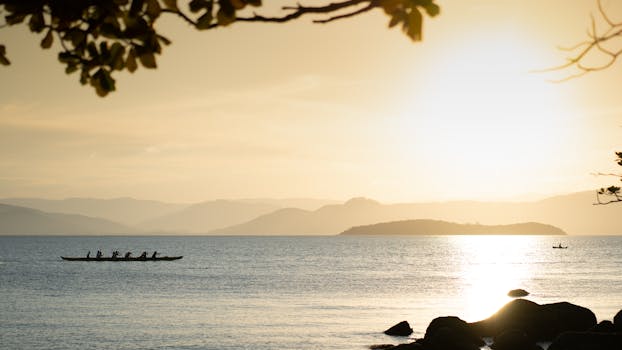Canoeing Adventures in the Amazon

The Amazon River offers one of the most unique and exhilarating canoeing adventures in the world. Spanning over 4,000 miles and flowing through nine countries, the Amazon basin is a vast network of rivers, tributaries, and rainforests teeming with diverse wildlife and rich cultural history. Canoeing through this natural wonder allows adventurers to experience its breathtaking beauty, encounter indigenous communities, and witness an unparalleled ecosystem up close.
Exploring the Amazon Basin
Canoeing in the Amazon basin provides an immersive way to explore this lush environment. The basin itself covers approximately 2.7 million square miles, making it the largest rainforest in the world. Adventurers can navigate through various tributaries such as the Rio Negro and Rio Solimões, each offering different sceneries and experiences. The dense vegetation and intricate water pathways create an ever-changing landscape that keeps explorers engaged throughout their journey.
One of the key highlights of canoeing in the Amazon is the opportunity to observe its incredible biodiversity. The region is home to over 400 billion individual trees representing around 16,000 species, as well as countless species of animals, birds, and insects. Canoeists often spot exotic wildlife such as pink river dolphins, caimans, and a plethora of bird species like macaws and toucans.
For those interested in cultural experiences, visiting indigenous communities along the riverbanks offers a chance to learn about traditional lifestyles and customs that have been preserved for centuries. These interactions provide a deeper understanding of how these communities coexist sustainably with their environment.
Essential Gear for Canoeing
Proper preparation is crucial for a successful canoeing adventure in the Amazon. Essential gear includes:
- Lightweight Clothing: Quick-dry and breathable fabrics are ideal due to the humid climate.
- Waterproof Bags: Essential for protecting personal belongings from water exposure.
- Navigation Tools: Maps, GPS devices, and compasses are crucial for navigating the complex waterways.
- First Aid Kit: Include supplies for common issues such as insect bites, cuts, and sunburn.
- Insect Repellent: To protect against mosquitoes and other insects prevalent in the region.
Canoeing also requires safety equipment such as life jackets and paddles. Given the remote nature of many areas in the Amazon, having a reliable communication device is also recommended to ensure help can be summoned in case of emergencies.
Navigating Safety Concerns
Canoeing in the Amazon is not without its risks. Understanding potential hazards and taking precautions can significantly enhance safety during your trip. Some common safety concerns include:
- Weather Conditions: The Amazon experiences heavy rainfall and unpredictable weather patterns that can affect river conditions.
- Wildlife Encounters: Encountering wildlife like caimans or snakes can be dangerous if not handled properly.
- Health Risks: Waterborne diseases and insect-borne illnesses like malaria are prevalent; vaccinations and preventive measures are crucial.
Canoeists should always travel with a knowledgeable guide familiar with the local environment and potential risks. Guides can offer invaluable advice on how to navigate safely through different sections of the river while providing insights into local customs and wildlife behavior.
The Best Time to Canoe
The timing of your canoeing adventure can greatly impact your experience. The Amazon has two primary seasons: wet (December to May) and dry (June to November). Each season offers unique advantages:
| Season | Advantages |
|---|---|
| Wet Season | Higher water levels allow access to flooded forests; increased wildlife sightings near riverbanks. |
| Dry Season | Easier navigation due to lower water levels; fewer insects; better hiking opportunities on exposed trails. |
The wet season's higher water levels enable canoeists to explore areas that are otherwise inaccessible during the dry season. However, it also brings more insects and potential challenges related to heavy rainfall. Conversely, the dry season offers easier navigation but limits access to certain areas due to lower water levels.
Canoeing through the Amazon provides opportunities for enriching cultural interactions with indigenous communities residing along its banks. These communities have lived in harmony with their surroundings for generations, practicing sustainable methods that modern societies can learn from. Engaging with locals offers insights into their daily lives, traditional crafts, culinary practices, and medicinal knowledge derived from native plants.
An example is visiting a Yagua village where visitors can participate in traditional dances or learn about blowgun hunting techniques passed down through generations. Such experiences foster respect for indigenous cultures while promoting responsible tourism that benefits local economies without disrupting their way of life.
Canoeing the Amazon River is more than just a thrilling adventure; it’s a deep dive into one of the world’s most diverse and culturally rich regions. As you paddle through these vast waters, you’ll find yourself in awe of the incredible balance of nature and the harmonious way local communities have thrived here for centuries.Before you embark on this unforgettable journey, make sure you have all the necessary permits and vaccinations. Learning a few local phrases and understanding basic customs can go a long way in showing respect and enriching your experience. These small efforts will make your interactions with indigenous communities more meaningful and rewarding.
Canoeing through the Amazon delivers winding tributaries, the diverse wildlife, and the rich cultural exchanges with indigenous people; all of which make for an experience that’s both enlightening and humbling. So, pack well, respect the environment, and let the spirit of the Amazon guide you through this incredible adventure.